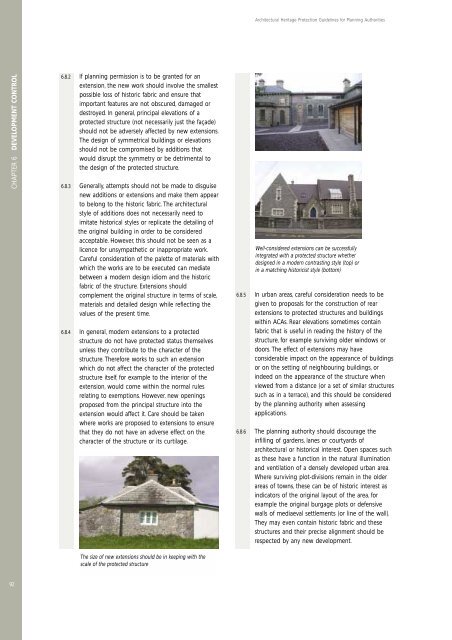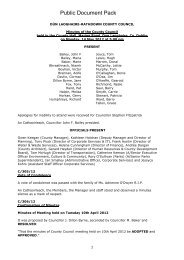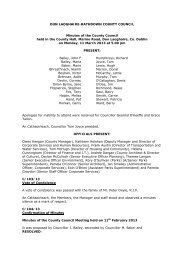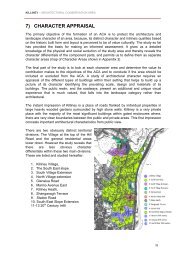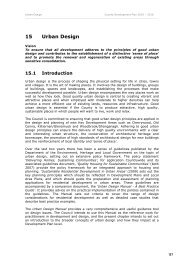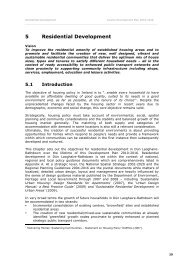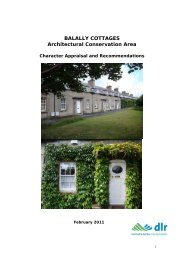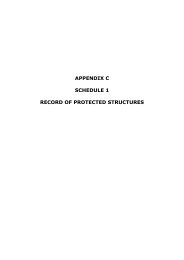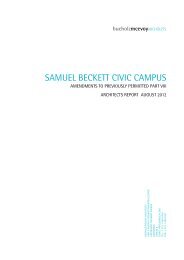Architectural Heritage Protection Guidelines for Planning Authoritiespractice and in line with the conditions of theplanning permission;k) reinstatement of previously removed features torestore the character of the structure (withaccurate detailing to be agreed if not alreadyresolved);l) phasing of work in a large-scale development soas to ensure that work to the protectedstructure is underway or will be completed intandem with, or prior to, completion oroccupation of new buildings.Recording as a condition of permission6.7.3 The demolition of a protected structure, or ofelements which contribute to its special interest,may only be permitted in exceptionalcircumstances. 21 Where the dismantling ordemolition of all or part of a protected structure ispermitted, it may be a condition of permission thata record be made of the structure prior to thecommencement of any works. 22 It should beconsidered that this is a permanent record whichwill have to substitute for the structure itself andshould be capable of detailed analysis andinterpretation.6.7.4 Such archive-standard drawings should be producedon polyester film, linen, acid-free or rag paper, usingpermanent black ink. In these circumstances, dyelineprints are not acceptable, nor are copies ofcomputer-aided design files. In addition to the fullset of drawings, copies of original survey notesshould be included with the report, as shouldcopies of relevant earlier drawings, photographswith negatives (preferably dated), plans and maps.6.7.5 Where a photographic record is to be made of all,or part of, a structure, the photographs should be ofhigh quality. The use of a professional photographershould be considered and, where appropriate, theuse of recording techniques such as rectifiedphotography could be required. Black-and-whitephotography should be used when creating apermanent archive-quality record. Where it isessential to make an archive record of the colour offeatures, such as old or interesting wallpapers orpainted decoration, colour slide film should be usedand should be considered to be a supplement to,not a replacement for, black and white photography.Historic photographs should be identified by theirarchive name and negative number. One or moresets of legibly-sized prints should be included (forexample, 20cm x 25cm).Architectural salvaging as a condition ofpermission6.7.6 The Act provides for making a condition of planningpermission, where appropriate, the salvage ofelements of special interest of a protected structure,or any element of a protected structure that is aboutto be altered or removed. 23 The removal of importantor decorative elements should only be permittedwhere the developer has indicated how theseelements will be used or maintained in the future,which, in order to mitigate the impact, should berelocated within the structure wherever possible. Insuch a case, the state of the structure or of therelevant interior spaces before dismantling shouldalso be recorded, and two copies of the report sentto the planning authority (one for forwarding to theIrish Architectural Archive). All items permitted forremoval and reinstatement should be tagged,photographed and stored securely, preferably on site.6.7.7 In the case of the industrial heritage this maypresent particular problems, and expert adviceshould be sought, for example from the IndustrialHeritage Association of Ireland.6.8 General Types of <strong>Development</strong>Extensions6.8.1 It will often be necessary to permit appropriate newextensions to protected structures in order to makethem fit for modern living and to keep them inviable economic use. Where the existing exteriorappearance of a structure is of special interest, andits interior is of sufficient size, it may be possible toincorporate new functions or services within theexisting envelope of the structure. With flexibilityand imagination, it may be possible to usesecondary spaces within the building, obviating theneed to extend, where there would be minimalimpact on fixtures and features of special interest.The cumulative effect of minor additions cancompromise the special interest of a structure andthe character of an ACA. The planning authorityshould consider this when assessing a proposal foreven small extensions.CHAPTER 6 DEVELOPMENT CONTROL21 Section 57 (10) (b), 2000 Act22 Section 34 (4) (p) (i), 2000 Act23 Section 34 (4) (p) (ii), 2000 Act91
Architectural Heritage Protection Guidelines for Planning AuthoritiesCHAPTER 6 DEVELOPMENT CONTROL6.8.2 If planning permission is to be granted for anextension, the new work should involve the smallestpossible loss of historic fabric and ensure thatimportant features are not obscured, damaged ordestroyed. In general, principal elevations of aprotected structure (not necessarily just the façade)should not be adversely affected by new extensions.The design of symmetrical buildings or elevationsshould not be compromised by additions thatwould disrupt the symmetry or be detrimental tothe design of the protected structure.6.8.3 Generally, attempts should not be made to disguisenew additions or extensions and make them appearto belong to the historic fabric. The architecturalstyle of additions does not necessarily need toimitate historical styles or replicate the detailing ofthe original building in order to be consideredacceptable. However, this should not be seen as alicence for unsympathetic or inappropriate work.Careful consideration of the palette of materials withwhich the works are to be executed can mediatebetween a modern design idiom and the historicfabric of the structure. Extensions shouldcomplement the original structure in terms of scale,materials and detailed design while reflecting thevalues of the present time.6.8.4 In general, modern extensions to a protectedstructure do not have protected status themselvesunless they contribute to the character of thestructure. Therefore works to such an extensionwhich do not affect the character of the protectedstructure itself, for example to the interior of theextension, would come within the normal rulesrelating to exemptions. However, new openingsproposed from the principal structure into theextension would affect it. Care should be takenwhere works are proposed to extensions to ensurethat they do not have an adverse effect on thecharacter of the structure or its curtilage.Well-considered extensions can be successfullyintegrated with a protected structure whetherdesigned in a modern contrasting style (top) orin a matching historicist style (bottom)6.8.5 In urban areas, careful consideration needs to begiven to proposals for the construction of rearextensions to protected structures and buildingswithin ACAs. Rear elevations sometimes containfabric that is useful in reading the history of thestructure, for example surviving older windows ordoors. The effect of extensions may haveconsiderable impact on the appearance of buildingsor on the setting of neighbouring buildings, orindeed on the appearance of the structure whenviewed from a distance (or a set of similar structuressuch as in a terrace), and this should be consideredby the planning authority when assessingapplications.6.8.6 The planning authority should discourage theinfilling of gardens, lanes or courtyards ofarchitectural or historical interest. Open spaces suchas these have a function in the natural illuminationand ventilation of a densely developed urban area.Where surviving plot-divisions remain in the olderareas of towns, these can be of historic interest asindicators of the original layout of the area, forexample the original burgage plots or defensivewalls of mediaeval settlements (or line of the wall).They may even contain historic fabric and thesestructures and their precise alignment should berespected by any new development.The size of new extensions should be in keeping with thescale of the protected structure92


